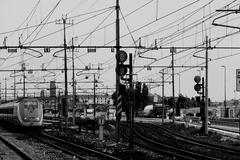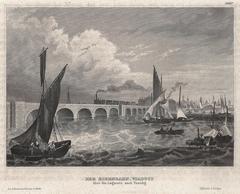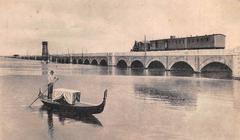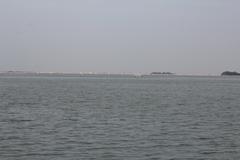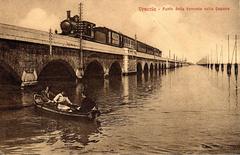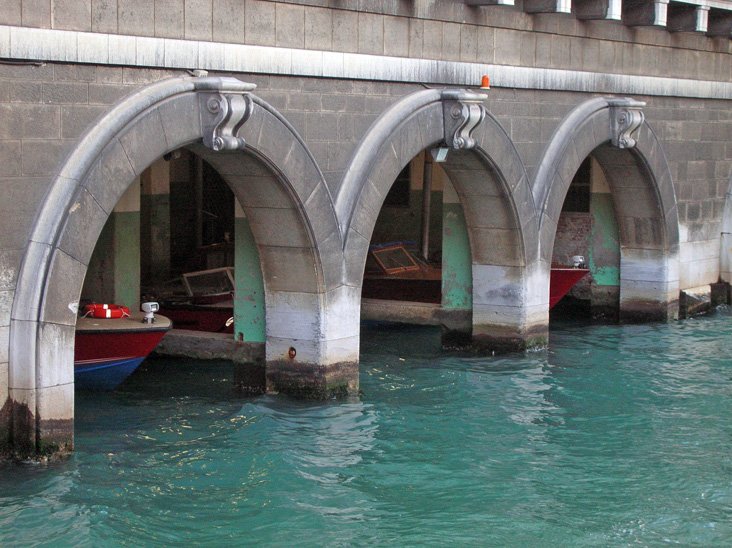
Ponte della Libertà Venice: Visiting Hours, Tickets, and Travel Guide
Date: 14/06/2025
Introduction
The Ponte della Libertà (Liberty Bridge) is the only vehicular and rail connection between Venice’s enchanting historic islands and the Italian mainland. Spanning nearly 4 kilometers across the Venetian Lagoon, this engineering marvel is not only vital for the city’s daily life and tourism but also stands as a powerful symbol of Venice’s resilience and adaptability. Whether you are arriving by car, train, bus, or tram, understanding the bridge’s history, visiting policies, and practical logistics will help you make the most of your Venetian journey.
For further reference, consult Europe for Visitors, Venezia Heritage Tower, and Visit Venezia.
Table of Contents
- Introduction
- Historical Background
- Visitor Information
- Transportation Overview
- Parking and Arrival Logistics
- Guided Tours and Nearby Attractions
- FAQs
- Visuals and Media
- Summary and Recommendations
- References
Historical Background
Early Transportation Challenges
For centuries, Venice’s status as a city of islands, crisscrossed by canals, made access from the mainland difficult. Until the 19th century, boats were the only means to reach the historic center, creating a unique but isolated urban environment (Europe for Visitors).
The Venice Railway Viaduct
In 1846, the completion of the Venice Railway Viaduct marked the first direct link between Venice and the mainland. This 3.6 km bridge enabled trains to reach Venezia Santa Lucia station, dramatically improving accessibility for residents and visitors. The railway bridge, running parallel to the future Ponte della Libertà, remains critical to this day (Europe for Visitors).
Conception and Construction of Ponte della Libertà
With the advent of automobiles and the need for broader connectivity, plans for a road bridge emerged in the early 20th century. Engineer Eugenio Miozzi designed the structure, and construction began in 1932. The bridge was completed and inaugurated in 1933, originally named Ponte Littorio to reflect the Fascist regime’s ethos (Venezia Heritage Tower; Venice Group Services).
Renaming and Symbolism
After World War II and the fall of Fascism, the bridge was aptly renamed Ponte della Libertà (“Liberty Bridge”) in 1945, commemorating Italy’s liberation. The renaming transformed the bridge into a symbol of freedom, renewal, and modernity for Venice and Italy.
Engineering and Structural Features
- Length: 3,850 meters (2.39 miles)
- Materials: Reinforced concrete and brickwork—innovative for its era, offering durability against the lagoon’s corrosive environment (Art-Facts)
- Design: Two vehicular lanes (one each direction), tram tracks, and a parallel railway viaduct. Dedicated pedestrian and cycle paths enhance accessibility and sustainability (Venice Group Services).
- Aesthetics: Rationalist, minimalist style emphasizing function over decoration.
Urban Integration and Socio-Economic Impact
Ponte della Libertà’s eastern terminus is Piazzale Roma, Venice’s main vehicular and transport hub, while its western end connects to Mestre and Marghera. The bridge catalyzed the urban growth of mainland districts, facilitating daily commutes, tourism, and goods movement (Europe for Visitors). Its parallel with the railway viaduct enables robust multi-modal transport, vital for Venice’s economic health.
Visitor Information
Visiting Hours and Access
- Open Access: The bridge is a public roadway and railway, accessible 24/7 year-round.
- Pedestrian & Bicycle Access: Officially, pedestrian and bicycle crossing is prohibited for safety reasons due to traffic and lack of continuous protected lanes (Visit Venezia). However, there are pedestrian paths on portions of the bridge, mainly for maintenance and emergency use. Always adhere to posted signs and regulations.
Ticketing and Venice Access Fee
- Bridge Crossing Fee: There is no charge to cross the bridge itself by car, bus, or train.
- Venice Access Fee (2025 Onward): Day visitors entering the historic center via Ponte della Libertà must pay an access fee on designated high-traffic days (mainly weekends, April to July). The fee ranges from €5–€10, payable online, via QR codes, or at authorized outlets (Visit Venezia).
- Who is Exempt: Overnight guests (paying the tourist tax), residents, workers, and students are exempt from the access fee.
- How to Pay: Use the official Venice tourism portal or authorized points. Fines apply for non-compliance.
Travel Tips and Accessibility
- Best Time to Cross: Early morning or late afternoon for lighter traffic and better light for photography.
- Weather: The bridge is exposed to wind and weather; dress accordingly.
- Accessibility: Piazzale Roma and Tronchetto Island are fully accessible with ramps and elevators. Public transport (buses, trams, trains) is equipped for travelers with disabilities.
Transportation Overview
- By Car: Enter via the SR11 route. Vehicles must park at Piazzale Roma or Tronchetto; no private vehicles are allowed in Venice’s historic center.
- By Train: All regional and high-speed trains arrive at Venezia Santa Lucia station, at the city end of the bridge.
- By Bus: Buses cross the bridge and terminate at Piazzale Roma.
- By Tram: Modern trams use dedicated tracks across the bridge, linking Mestre and Venice.
- Parking: Secure parking is available at Tronchetto Island (~4,000 spaces, €21/day) and Piazzale Roma (higher rates, proximity advantage). Book parking in advance during high season.
- On Foot/Bike: Pedestrian and bicycle access is generally restricted; use alternative routes or public transport.
Parking and Arrival Logistics
- Piazzale Roma: Closest to the city center, offers multi-story garages (from €35/24h). Advance booking recommended.
- Tronchetto Island: Large, secure parking, with People Mover shuttle to Piazzale Roma in under 5 minutes.
- Mestre/Marghera: Cheaper parking options with frequent bus/train transfers into Venice.
Guided Tours and Nearby Attractions
- Guided Tours: Several walking and cycling tours include the bridge approach and Piazzale Roma, providing insights into Venice’s modern infrastructure and history.
- Special Events: The Venice Marathon and other cultural events may use Ponte della Libertà as part of their route.
- Nearby Attractions:
- Piazzale Roma: Main transport interchange, shops, and cafes.
- Venice Historic Center: St. Mark’s Square, Doge’s Palace, Rialto Bridge.
- Tronchetto: Parking, ferry connections, and People Mover.
- Mestre & Marghera: Dining, shopping, and industrial heritage.
Frequently Asked Questions (FAQs)
Q: What are the Ponte della Libertà’s visiting hours?
A: The bridge is open 24/7 as a public thoroughfare.
Q: Do I need a ticket to cross Ponte della Libertà?
A: No ticket is required for the bridge, but day visitors must pay the Venice Access Fee on select days (Visit Venezia).
Q: Can I walk or cycle across the bridge?
A: Officially, pedestrian and bicycle access is restricted for safety. Use designated public transport options.
Q: Is the bridge accessible for people with disabilities?
A: Piazzale Roma and Tronchetto offer accessible facilities. Public transport is generally equipped for wheelchair users.
Q: Are there guided tours involving Ponte della Libertà?
A: Yes, some tours include the bridge approach and highlight its history and significance.
Visuals and Media
Alt text: View of Ponte della Libertà bridge connecting Venice to the mainland with cars and tram tracks visible.
Alt text: Map highlighting Ponte della Libertà and surrounding areas in Venice.
Summary and Recommendations
The Ponte della Libertà is more than a bridge—it is Venice’s lifeline to the mainland, an emblem of modernity, and a testament to engineering prowess. It enables the city’s economic, social, and cultural vitality by supporting multi-modal transport and sustainable tourism. As of 2025, remember to book your Venice Access Fee in advance if you are a day visitor, and plan parking or public transport accordingly. For a seamless arrival, avoid peak hours, use official parking, and leverage the city’s excellent public transport network. For additional resources, see Europe for Visitors, Visit Venezia, and Venice Group Services.
References
- Ponte della Libertà: History, Visitor Info, and Travel Tips for This Iconic Venice Landmark (Venezia Heritage Tower)
- Ponte della Libertà: Visiting Hours, Tickets, and Guide to Venice’s Iconic Bridge (Venice Group Services)
- Ponte della Libertà Bridge in Venice: Visiting Hours, Tickets & Travel Tips (Civilisable & Europe for Visitors)
- Bridges of Venice: Ponte della Libertà and Pontoon Bridge (Europe for Visitors)
- Venice Access Fee Information and Calendar 2025 (Visit Venezia)
- Venice Connectivity Overview (Europe for Visitors)
- Ponte della Libertà (Wikipedia)
- Official Venice Tourism Portal
- Venice Transportation Info
- Venice Access Fee Details

